Hunting a cartel hitman was a daunting challenge. Border politics made it even harder
ZAPATA, Texas – E.J. Salinas was fast asleep in his home in Laredo when the buzz of his cell phone jarred him awake.
He was used to the late-night phone calls. As a Texas Ranger responsible for high-profile cases in small towns, Salinas routinely received calls, usually from sheriff’s deputies and justices of the peace. He would roll to the scene of South Texas’ most heinous crimes – murders, bodies in the brush, home invasions, kidnappings.
The midnight calls came so frequently that Salinas made a habit of laying out his work outfit – crisply-pressed dress pants and shirt, Stetson hat, .45-caliber Sig Sauer – over a chair in a corner of the room, ready to go.
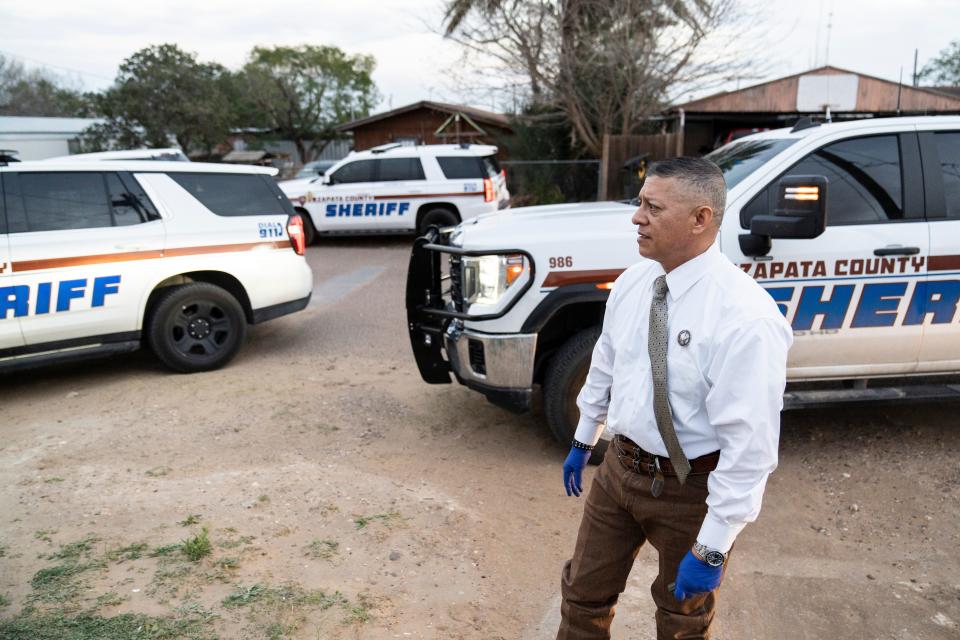
The call Salinas received just past midnight on April 14, however, was different: It was from a U.S. Border Patrol agent, not usually the ones calling. Border Patrol had picked up a smuggler leading a team of migrants through thorny brush. When agents ran the man through a biometric ID system, it triggered an alert.
The man’s name was Justino Alonso-Hernandez. Salinas had been looking for him for nearly three years.
The case in question was a cartel-style murder. In tiny Zapata, far down the Rio Grande, a 22-year-old man had been gunned down with an assault rifle in his bedroom at his parents' home. Soon after the July 2021 murder, sheriff’s deputies had arrested two people suspected of being the getaway drivers. But the gunmen – sicarios – were believed to be members of the "Tropa del Infierno," a group of hitmen working for the Cartel Del Noreste, who had slipped back into Mexico, leaving behind only grainy security footage and a single, partial palm print.
Finding them from north of the border would have been daunting in the best-case scenario. In the three years since the shooting, border politics had only worsened the chances Salinas would get help finding either gunmen.
Now, one of the alleged gunmen was sitting in a Border Patrol holding cell in Zapata, 50 miles away. Salinas slid into his clothes, holstered his pistol and gunned his black Silverado into the predawn darkness.
The USA TODAY app gets you to the heart of the news — fast. Download for award-winning coverage, crosswords, audio storytelling, the eNewspaper and more.
A cartel hit
Santos Flores III had been sulking around his parent’s house in the summer of 2021.
At 22 years old, he was father to an 8-year-old boy, Santos Flores IV. But he had split up with the boy’s mother a few years earlier and spiraled into a lingering depression. He spent most days holed up in his bedroom. Santos had never graduated from Zapata High School, so lately he had turned his focus to passing a high school equivalency test, or GED, and getting his diploma. Study guides were stacked on his nightstand, pencils wedged in pages he had last read.
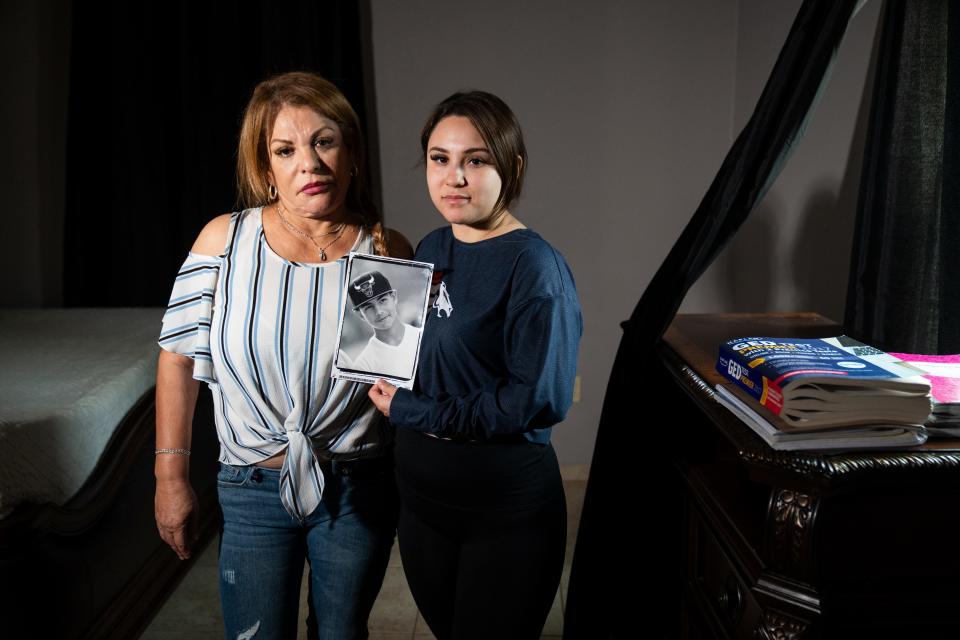
Santos slept in the downstairs bedroom of a two-story, cream-colored home decorated with faux roman columns and a busted fountain in the front yard. His sister, Elizabeth, 29, slept in an upstairs bedroom and his parents – Maria Flores, 56, a native of Sinaloa, Mexico who had lived in Zapata for 40 years, and Santos Flores, Jr., 63 – resided in a two-story apartment next to the home. His mother called Santos “Tercero,” or “Third.” His sister called him “Chato.”
At about 5 a.m. on July 23, 2021, Maria awoke to use the bathroom when she was startled by the sounds of nearby gunshots: four muffled reports followed by one much louder one. They sounded like they were coming from the street outside, she thought, perhaps a neighbor’s house. She roused her husband and called 911.
More shots rang out inside the main home. Elizabeth, awakened by the gunfire, crept downstairs and peered around the stairwell. Sulfuric smoke from the gunfire wafted in the living room.
Just then, two men – one slender with his face covered by a mask, another stocky, unmasked and carrying an assault rifle – emerged from her brother’s bedroom. The three of them locked eyes. Then the men scampered out of the house and down the street.
Elizabeth padded to her brother’s bedroom and found Santos wedged under his bed, where he had crawled to hide.
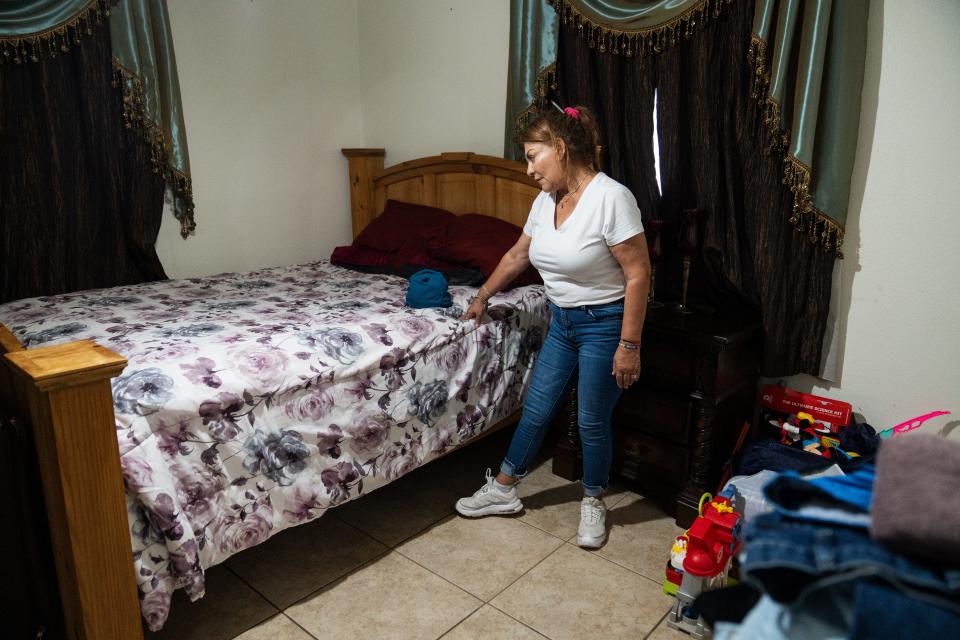
Bullet holes punctured the mattress. Beneath it, Santos was facedown. Blood poured from a wound in his head. She watched as her brother wheezed out his final breaths. Then she ran for her parents.
“?Mataron a Chato!” Elizabeth told them. They killed Chato.
A vexing clue
The Flores home soon flooded with law enforcement agents: Zapata County Sheriff’s deputies, crime scene analysts, the district attorney. Among the lawmen: Salinas, the Texas Ranger, who had been alerted by the sheriff’s office. Salinas surveyed the yard and home, interviewed Elizabeth and Maria and inspected Santos’ body, still lying under the bed in his bedroom. He had scrambled under his bed to avoid the gunmen. They had shot through the mattress and killed him.
Several bullet holes marred the doorframe – the initial shots Maria had heard were the gunmen shooting their way into the home. Investigators tagged shell casings throughout the property.
One of the first deputies on the scene, Lt. David Moya, had noticed a familiar white Ford truck with oversized chrome rims and blue headlights racing from the neighborhood. After reviewing footage from his dashcam, he recognized the truck as belonging to a man in town whom detectives knew well – he had had brushes with the law, including smuggling migrants.
In the end, two men were taken in for questioning. They told investigators they had picked up two gunmen from the border and had driven them to the Flores home, according to a criminal complaint filed in the case. They didn’t know anything about what happened inside the house, they said, or who the men were. Afterward, they said, they had driven the two men back to the border, where they slipped back across into Mexico.
An informant working with the sheriff’s office told authorities Santos owed more than $200,000 to the powerful Cartel del Noreste, which operated just on the other side of the border, after a botched cocaine shipment, according to the complaint. The sicarios were sent to collect on that debt.
The men from the white truck told investigators they couldn’t identify the gunmen, but investigators had a tantalizing clue: Surveillance video gleaned from a nearby home showed one of the gunmen had placed his hand on the hood of the white pickup. The identity of Santos’ killer possibly lurked within the intricate ridges and furrows of that handprint.
Investigators also confiscated the two men’s phones and extracted phone numbers, texts and social media postings. The phone numbers likely contained a trove of cartel connections, but the address book didn’t list any names, just nicknames.
The men from the pickup truck were charged with murder and later released on bond. They had handed investigators a remarkably quick lead in the case.
Within just 48 hours of one of the most gruesome murders Zapata County had ever seen, investigators had a handprint from the person who may have pulled the trigger.
Yet at the same time, the case had veered into one of the most challenging scenarios that a law enforcement officer can face in the region. The crime had happened in the United States, but the criminals had vanished into Mexico.
Maps and graphics: Operation Lone Star: What's happening in Eagle Pass, Texas?
Operation Lone Star
Salinas, 55, is one of 172 Texas Rangers across the state. The rangers, who have been protecting life and property in Texas since 1823, have evolved from the hardscrabble image of horse-riding, Winchester-rifle-wielding lawmen to specialized investigators today under the auspices of the Texas Department of Public Safety. Backed by years of training and the sizable resources of the state of Texas, the rangers often take the lead in high-profile cases, such as murders and kidnappings, lending their expertise to smaller law enforcement departments.

Growing up on a ranch near Oilton, Texas, Salinas knew he’d someday be a lawman. His father, Ernesto Juventino Salinas, was a justice of the peace and Salinas grew accustomed to residents knocking on the door of their ranch house at all hours of the day and night to report a dead body or missing truck. At age 6, he’d survey the cars parked outside his father’s grocery store and gas station and jot down their license plate numbers – in case someone tried to rob his daddy’s store.
After college and local law enforcement gigs, Salinas became a Texas state trooper in 1997 and was promoted in 2011 to ranger, beating out dozens of other candidates. Cases ranged from oilfield thefts to police shootings to high-profile homicides. In 2018, he helped hunt down the Laredo serial killer, Juan David Ortiz, a U.S. Border Patrol supervisory agent arrested and convicted of murdering four women.
In recent years, Salinas’ job has gained heightened significance, as he’s based in Laredo and deals primarily with crimes along the border. Part of his job is to hunt down sicarios like the pair believed to have killed Santos. At the same time, growing political turmoil has changed the view of what security means at the Texas-Mexico border.
Since launching in 2021, Operation Lone Star, Texas Gov. Greg Abbott’s $11 billion border initiative, has grown exponentially in budget, manpower – and political controversy. The Biden administration has complained that the operation’s tactics, which includes lacing riverbanks with concertina wire and deploying buoys in the Rio Grande, block federal border agents from reaching migrants and that state officials are overstepping their roles by enforcing border security, a federal task.
Abbott, who has criticized the Biden administration's handling of border security, has used the operation to build more statewide control over border security. The federal government has sued Texas over the issue, including one lawsuit challenging the state's right to deploy buoy barriers. In January, the U.S. Supreme Court ordered Texas to allow federal border agents access to the state’s border with Mexico. Mexican officials have also balked at parts of the operation they view as overly aggressive toward migrants.
Operation Lone Star has infused money into border law enforcement agencies and initiated cooperation between state troopers, rangers and sheriff’s deputies to combat crime on the border and repel undocumented migrants. Still, the effort adds a layer of complexity to Salinas’ job.
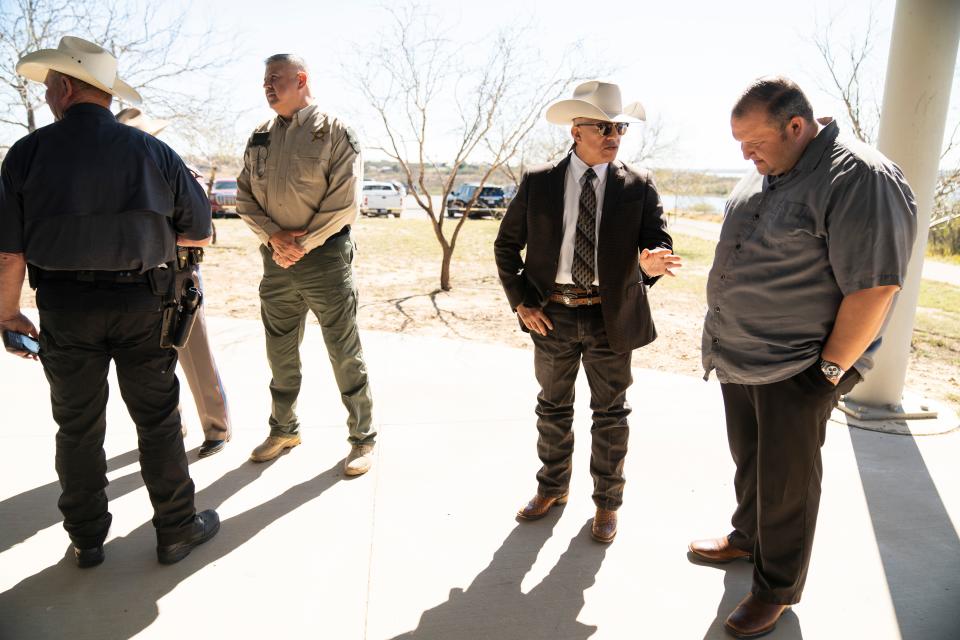
The more Mexico views Operation Lone Star, including the razor wire and several recent migrant drownings associated with the initiative, as heavy handed, the less willing Mexican officials may be in cooperating with cases and hunting down suspects on their side of the border, said Jerry Robinette, a retired Homeland Security Investigations special agent based in San Antonio.
“No doubt these politics are making it extremely awkward for Mexican authorities to work with U.S. authorities,” he said. “And vice versa.”
Through years of investigating transborder crimes, Salinas had developed “workarounds” for finding people on the other side. A few weeks after the Santos shooting, he reached out to a colleague at DPS with contacts in Mexican law enforcement. But at the time, Abbott had ordered troopers to inspect trucks coming across the border, clogging border crossings and rankling Mexican officials. The agent told him it “wasn’t a great time” for cross-border cooperation.
“Mexico’s not going to play ball right now,” he told Salinas.
Even before Operation Lone Star, pursuing criminals across the border had been politically fraught.
To do it, law enforcement officials need to start the costly, drawn-out process of seeking what’s known as a “provisional warrant” with intent to extradite, said Hector Gomez, a retired Austin-based supervisor with the U.S. Marshals Service who oversaw the agency’s Lone Star Fugitive Task Force.
All the documents in the case need to be translated into Spanish. Authorities need to have an accurate name, passport number and address for their suspect. Even if a Mexican judge approves the warrant, they then have to wait for police officials there – often outgunned by the cartels – to form a task force and make the arrest, he said.
At any step of the process, the entire effort can break down. During the 15 years Gomez oversaw the task force, from 2002 to 2017, the group extradited just 12 suspects from Mexico.
“It’s very cumbersome,” he said. “We’re talking months to even years.”
A cartel connection makes the process even harder. For example, Gomez said his team learned not to ask to pursue anyone connected with the Sinaloa Cartel – the Mexican government deemed it too risky of a pursuit. Other times, his task force would hear of a wanted suspect killed off by a drug syndicate because the person was bringing unwanted attention, he said.
In the end, Gomez said, U.S. officials often decided it made more sense just to wait.
“What would have been a multi-year effort, now you got them walking across the border and you have them within six months,” he said. “Sometimes it’s just plain luck.”
Making small cases, waiting on big clues
Barring any midnight phone calls, Salinas usually awakes each morning around 4 a.m., dresses, mixes a shake of kale, spinach, berries, whey protein and apples and pours black coffee into a Yeti tumbler. Barrel-chested and stocky, with brown eyes that sag slightly at the corners, Salinas said the agency’s physicals keep him in shape. He crams a bulging accordion file folder of his active cases and some lingering ones, such as the Santos case – around six total – in the backseat of the truck. The folder travels with him everywhere he goes, in the event there’s a sudden break. On days he works from Zapata, he drives an hour along darkened Highway 83 to the sheriff’s office, where he has a dedicated desk.
On a recent day in Zapata, Salinas and Sheriff’s Deputy Ramon Arambula inspected a Ford Explorer in an empty lot, believed to have been stolen and abandoned by smugglers. Salinas snapped on blue surgical gloves, poked around the dash and took pictures.
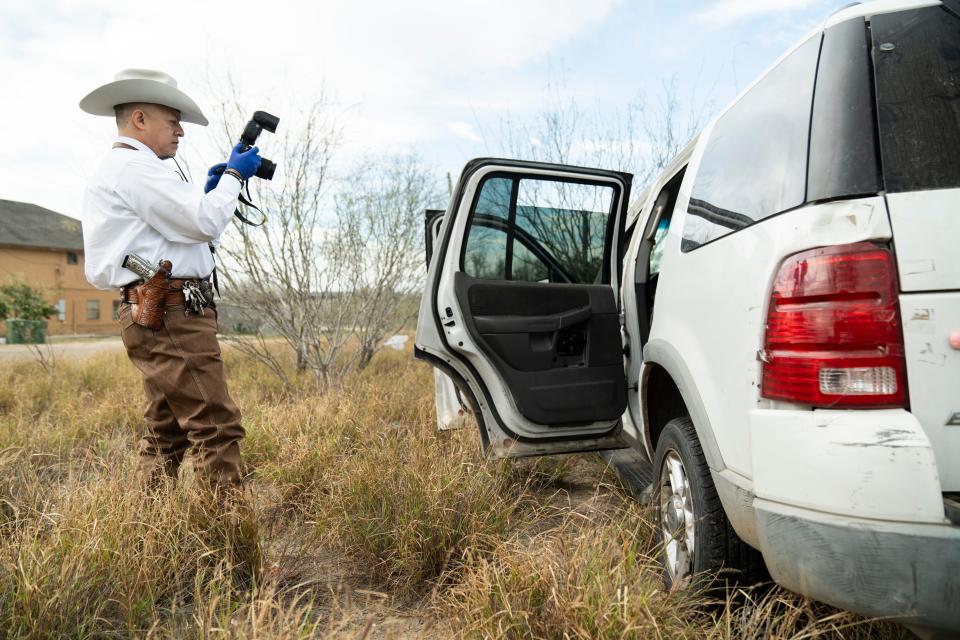
Next, they knocked on an apartment door where a 14-year-old runaway from West Texas was suspected to be hiding. No one answered. A manager at the apartment complex let them in and a woman, claiming to be the girl’s mother, appeared, saying the girl was her daughter but she hadn’t seen her in months. Behind her in the apartment, a “HAPPY BIRTHDAY” sign was strung across a living room wall, and sheets and a pillow were strewn on a couch, as if someone had recently slept there. Salinas and Arambula asked if they could enter the apartment and were allowed in. Minutes later, they emerged with the missing teenage girl. The mom was placed in handcuffs and driven to the station.
Later that afternoon, Salinas and Arambula joined several other sheriff’s departments from around South Texas – all in Zapata for a special effort driven by Operation Lone Star – and raided a mobile home in the center of town suspected to be occupied by a drug dealer. The two lawmen, along with five other agents, walked into the dusty front yard, sidestepping roosters, and banged on the front door. A dazed woman in her 20s opened the door. Inside, dirty dishes were piled in a sink, a half-eaten pork chop still stuck to one. A small couch sat in the living room. In a bedroom, agents found several small baggies filled with marijuana, several THC vape pens and a bag of Xanax bars. The woman was patted down and led away in handcuffs.
Salinas said he realizes the arrests that day were relatively minor. But, he said, he rarely turns down the opportunity to participate in a bust, even the smallest ones, because he never knows when a smaller crime – a stolen truck, a 14-year-old runaway, a minor drug investigation – could lead to a clue or break in one of his bigger cases, such as the Santos Flores murder. In small towns like Zapata, crimes are often connected.
***
Shortly after his DPS colleague told him his contacts in Mexico were unwilling to help, Salinas reached out to the Bureau of Alcohol, Tobacco and Firearms. He was told it would take a lengthy process, involving reams of paperwork and likely months of bureaucracy, to start looking for someone in Mexico. He thanked the agent and set that idea aside.
Salinas knew his next steps would possibly involve reaching out to the U.S. Marshals Service and persuading the local district attorney’s office to apply for provisional warrants.
Isidro Alaniz, the district attorney for Webb and Zapata counties, submits perhaps two provisional warrant requests a year to the Department of Justice.
“Some of them stay in the pipelines for years,” Alaniz said.
Still, the warrants often deliver. In October 2018, Mexican authorities executed a provisional warrant on Victor Manuel Palomo, a murder suspect who had evaded police for seven years. Palomo had been arrested and tried in July 2011 for the shooting death of a Laredo man. During a break in his murder trial, he escaped and fled to Mexico. He was finally caught in Nuevo Laredo and returned to Webb County, where he was sentenced to 99 years in prison.
“It’s costly, involves a lot of manpower and takes a lot of time,” Alaniz said. “But it works.”
Alaniz said he never filed a provisional warrant in the Santos case because he believed the DEA was investigating the incident and would file it. A DEA spokesman in Houston wouldn't comment on the case or whether his agency ever filed a provisional warrant, citing agency rules about talking about open investigations or wanted fugitives.
And Salinas remained exactly where he was: He had a crucial clue, but no suspect – until he ran into two men with laptops who could offer him a new lead.
***
As Salinas pondered his next move, he received a call from an FBI agent based in Laredo: He had heard of the Flores case and knew of two Mexican intel analysts who could help, he told Salinas. A few days later, he met with the agent and the Mexican officials at the FBI office in Laredo. Sitting around a table in a conference room, the analysts popped open laptops as Salinas shared the phone numbers, texts and WhatsApp messages gleaned from the man with the white pickup truck.
Tapping into Mexican databases, the analysts provided Salinas with four names to the phone numbers and the WhatsApp messages. One WhatsApp voice message in particular, just hours after the murder, piqued investigators’ interest: The sender discussed details of the incident only investigators knew about. The phone number was traced to Justino Alonso-Hernandez, a Mexican national.
Now armed with actual names, Salinas alerted contacts at Border Patrol to some of the people he was looking for. The four names, including Alonzo-Hernandez’s, went into the agency’s Automated Biometric Identification System, known as IDENT. The database captures the identity of foreigners and migrants wanted for criminal offenses in the U.S. If those people end up in the hands of Border Patrol later, the system triggers agents to alert other law enforcement. Salinas calls it a “silent alarm.”
But the case was stuck much in the same spot it had been in before: Wanted Mexican nationals still unreachable on the other side of the border. He could only hope that a federal agency would help hunt them down. Or that one of the gunmen would return to the U.S.
A family mourns
All around her each day, Maria Flores is reminded of the night strangers shot her son.
Bullet holes scar the floor of her living room and are lodged into the armrest of the loveseat. She got rid of the bed Santos scrambled under, trying to evade the gun-toting sicarios. But the wall in the bedroom is scarred with bullet holes, spackled over but still visible.

Maria keeps a box with her son’s personal items: a bottle of Dolce & Gabbana cologne, Sensodyne toothpaste, wired iPhone headphones. The top of his dresser is still stacked with Kaplan GED study guides and a Spalding basketball.
The sheriff and Salinas were initially empathetic and kept her abreast of the case’s progress. But as leads fizzled and months stretched into years, they stopped returning her phone calls, she said.
Maria said she doesn’t believe the informant who told investigators Santos had been mixed up with the Noreste cartel. Her son wasn’t an ideal student and got into occasional trouble at school, she said. But he steered clear of criminals and stayed away from drugs. He had never been arrested, according to Zapata County records.
“My son wasn’t a bad person,” Maria said. “He was very serious. He wouldn’t talk with just anyone, but he wasn’t bad.”
Elizabeth said Santos had played football in high school. After his GED, she said, he had his sights on studying business at Texas A&M International University in nearby Laredo.
“It’s been very, very hard,” she said. “We want to know who it was and for everyone involved to go to jail. Most importantly, we want to know why.”
County records show Santos’ father, Santos Flores Jr., had been arrested three times since 2001 for drug possession and “attempted delivery of a controlled substance” and in one case was ordered to perform community service. Flores Jr. was not available for an interview with USA TODAY. But Maria rejected the idea that hit men would have been after anyone in her family. “Anyone who knows us knows we’re in the other building,” she said. “Why would they go into the main house if they wanted my husband?”

The incident sent Maria on a mental spiral. She began drinking heavily and got three DUIs in two years. She put the house on the market for several months, trying to get rid of the memories, but it wouldn’t sell.
Lately, she’s been seeing a therapist and has quit drinking. She sees Santos’ son – whom she calls “Cuartito,” or “Little Fourth” – occasionally for birthday pi?ata parties or play visits. But memories of her son – and the pain they evoke – are a constant.
“I miss him so much,” Maria said through a rush of tears. “They killed my son like he was a dog. I want justice.”
Zapata County Sheriff Raymundo Del Bosque said he feels for the Flores family. In the weeks and months after the shooting, Maria would call his office twice a week, sometimes more. But with limited resources and gunmen believed to be in Mexico, there’s only so much his department can do, he said.
“It’s heartbreaking,” Del Bosque said during an interview in his office. “The mom keeps calling our office because she wants answers. We’re trying our best.”
Closer to the killers
After being awoken by the early morning phone call by Border Patrol on April 14, Salinas drove along the darkened highway to the Zapata County Sheriff’s Office. Deputy Arambula met him there.
Together, they printed out the phone number and name used by the sicario suspect, Alonso-Hernandez. They readied audio files of the WhatsApp messages. Then, they drove up U.S. Highway 83 to the Border Patrol outpost in Zapata.

Inside a small, windowless conference room, Salinas sat at a table with the suspect. He asked the federal agents to remove the suspect’s handcuffs, then talked to him in his native Spanish. He told him he didn't think it fair to write his report without first hearing his side of the story. He showed Alonso-Hernandez printouts of his phone number and played recordings of the WhatsApp audio.
At first, Alonso-Hernandez denied everything, Salinas said. Slowly, he began to come clean: That was his phone number. That was his voice in the WhatsApp audio and, yes, he had worked with the man with the white pickup truck in the past, smuggling people into the U.S. Still, he denied any involvement in the shooting and volunteered to take a polygraph test to confirm his veracity, Salinas said. Though such tests generally can't be used in court, the polygraph test “detected deception,” he said.
Border Patrol handed Alonso-Hernandez over to the Zapata County Sheriff’s office, who charged him with murder and placed him in county jail.
Salinas said he believes Alonso-Hernandez may not have been the gunman but was one of the two men at the home the night Santos was shot. They plan to keep talking to him with the hopes he’ll either confess to the crime or point them to others involved in the shooting. Meanwhile, Border Patrol is processing Alonso-Hernandez’s fingerprints to compare them with the handprint lifted from the car.
For now, Salinas said he’ll keep chiseling away at the corners of the case, hoping for another sicario misstep or break in the case.
“It’s frustrating,” he said. “I take it as a challenge. But it does frustrate me.”
After speaking with the suspect and typing up notes at his desk at the Zapata County Sheriff’s Office, Salinas packed up his files, tucked away new criminal complaints and drove back up Highway 83 toward his home in Laredo. His accordion file containing Santos Flores’ case file was wedged in its spot in the back seat, now a few pages thicker.
Jervis is an Austin-based correspondent for USA TODAY. Follow him on X: @MrRJervis.
This article originally appeared on USA TODAY: A grisly murder, a Texas Ranger and the hunt for a cartel sicario
Solve the daily Crossword

